kyanther
|
| posted on 11/7/07 at 06:56 PM |

|
|
rosejoint sus. pics please!
anyone got pics for the front suspension please?
|
|
|
|
|
Avoneer
|
| posted on 11/7/07 at 07:26 PM |

|
|
http://locostbuilders.co.uk/viewthread.php?tid=48105
No trees were killed in the sending of this message.
However a large number of electrons were terribly inconvenienced.
|
|
|
RazMan
|
| posted on 11/7/07 at 08:01 PM |

|
|
Any help?
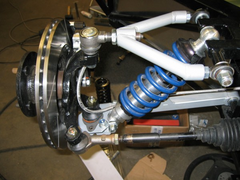 
Rescued attachment Front Wishbones.jpg
Cheers,
Raz
When thinking outside the box doesn't work any more, it's time to build a new box
|
|
|
kyanther
|
| posted on 11/7/07 at 08:12 PM |

|
|
thanks
do they all need to be that way around, i was thinking rose to replace top and bottom ball joints, didnt know if roses were up to taking weight so was
thinking mounting a rose bearing on lower plate.
you see im looking at fabricating the uprights so would make them rose friendly instead of conversion!
Or am i talking ....... well rubish?
ps you got me thinking about internal mounts now, was going to leave them as bushes!..... thanks!!!
|
|
|
RazMan
|
| posted on 11/7/07 at 08:20 PM |

|
|
If I did it all again I would use poly bushes on the wishbones - my rose joints failed after 5K miles and I just fitted replacements at £25ish each. I
definitely wouldn't use them for upper and lower ball joints - they wouldn't last five minutes.
Cheers,
Raz
When thinking outside the box doesn't work any more, it's time to build a new box
|
|
|
nitram38
|
| posted on 11/7/07 at 08:39 PM |

|
|
quote:
Originally posted by RazMan
If I did it all again I would use poly bushes on the wishbones - my rose joints failed after 5K miles and I just fitted replacements at £25ish each. I
definitely wouldn't use them for upper and lower ball joints - they wouldn't last five minutes.
Try McGill Motorsports around £4 each not £25!
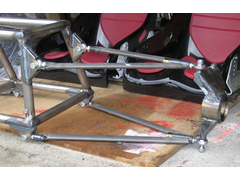 
front upright on bones
 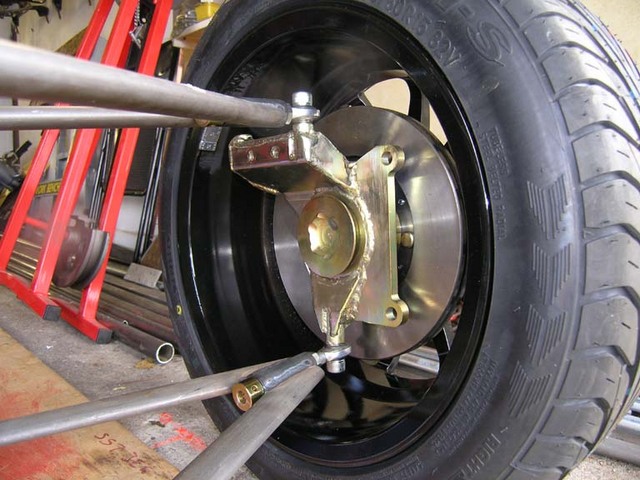
Description
[Edited on 11/7/2007 by nitram38]
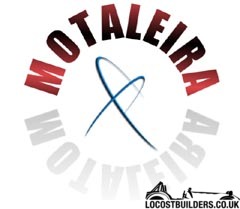
|
|
|
kyanther
|
| posted on 11/7/07 at 08:49 PM |

|
|
got my eye on mcgill thanks!!
what size type rate were the ones that gave up and was it down to race or road
oh were they on a seven?
|
|
|
RazMan
|
| posted on 11/7/07 at 10:15 PM |

|
|
With all due respect to McGill, I doubt that a £4 rod end will be up to much - I have learned that you get what you pay for where rod ends are
concerned. They might be ok for one or two races but mine is a road car so long life is a priority, although most race car builders that I know tend
to spend over £20 - £50 per rod end. Have a word with Autosport Bearings and they will give you a spec for your application, also Nick Skidmore will
give you accurate advice. Don't compromise on your suspension - your life literally depends on it.
My supplier says that the failed rod ends were 'good quality' ones but I can't confirm which manufacturer made them because there
were no markings so I am guessing that they not as good as he thought they were. The replacements are made by Aurora with a known spec and load limit.
PTFE liners are a must in any case.
p.s My car is a middy but with similar suspension to a Seven.
[Edited on 11-7-07 by RazMan]
Cheers,
Raz
When thinking outside the box doesn't work any more, it's time to build a new box
|
|
|
RazMan
|
| posted on 11/7/07 at 10:23 PM |

|
|
Nitram38 - Are you sure you wouldn't be better off with ball joints on those uprights?
Rod ends are designed for the transmission of loads where the loads are colinear to the axis of the stud, i.e., rod ends are the load points in a
‘two-force’ body that push and pull along the axis of the rod end stud. Rod ends in that orientation (rotated 90 degrees) will be severely compromised
and a ball joint would have more bearing area in the vertical plane imo. I'm willing to be proved wrong though 
 
Description
[Edited on 11-7-07 by RazMan]
Cheers,
Raz
When thinking outside the box doesn't work any more, it's time to build a new box
|
|
|
Doug68
|
| posted on 12/7/07 at 01:42 AM |

|
|
I have to concur with RazMan. Its just a matter of time before the bottom outer rod end will break.
That is if the bump loads are going through the bottom outer rod end before getting to the push rod that I assume is going be in the design.
The only way this can be avoided (and I would like to be proved wrong) is to mount the push rod directly off of the upright which will be tricky to do
at the front.
|
|
|
nitram38
|
| posted on 12/7/07 at 04:51 AM |

|
|
I have covered this loads of times before in posts that are years old.
Have a look at race cars. Many have rose joints this way around. My F1-2 has them this way around and so far 1400 miles and no problems. 7 ball
joints were designed for a car weighing around 1200 kg originally. My car will be around 500kg.
The photos show the car in the building stages so the bolts do not have the washers on that act as a safe guard.
The washers are no ordinary ones either. I use them on the F1-2 and they come from pegasus racing in the U.S.
Here is a photo of the F1-2, a bit big and before anyone comments, the angle of the wishbone is caused by the car being off the floor and not set
up.
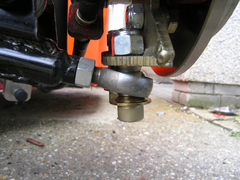 
Description
Front bottom rod end on Ariel Atom and it doesn't even have a safety washer!
My bolts are drilled for lockwire and I will also be putting a grubscrew in the upright.

[Edited on 12/7/2007 by nitram38]

|
|
|
Doug68
|
| posted on 12/7/07 at 05:59 AM |

|
|
nitram38 a number of points:
1. Race cars are not road cars the bump loads into the suspension of a road car will far exceed those ever seen by a race car. Racing vehicles are
subject to far more stringent servicing schedules than that for a road vehicle.
2. The load in the joint in question is a function of the g it is submitted too and the unsprung mass it is supporting. The sprung mass of the
vehicle has very little to do with it.
3. Failure of the ball region is not what I would worry about, normally where these joints fail is at the root of the threaded section (circled in
picture below).
4. The picture of the Vortex shows a captured spherical bearing as the bearing for the lower end of the upright. This is a far superior solution to
using a rod end in bending. As the bending loads are taken in the welded structure of the bottom 'A' arm rather than through the threaded
section of the rod end.
 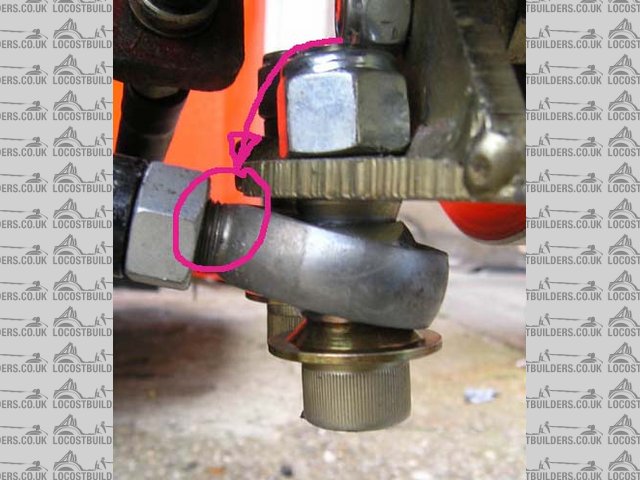
Rescued attachment RodEnd.jpg
|
|
|
Doug68
|
| posted on 12/7/07 at 06:15 AM |

|
|
Read this for further
information.
|
|
|
nitram38
|
| posted on 12/7/07 at 06:39 AM |

|
|
The Atom is a proven road car.
I removed the vortex picture because it is not a good example.
There also lots of other pictures on my hardrive, but I am at work at the moment.
The article you suggested also says that bigger Rod ends would do, but in a racing enviroment, they should be small and that is the reasoning behind
the change.
Quote "Of course if the rod ends are big enough they will not break, but the Design Judges argue that if the system is correctly designed, then
smaller and lighter components can be used, and this has a flow on effect to the sizing of other components"
In otherwords, they will not break if you use big enough rod ends.
My rod ends are 1/2" UNF and are sufficient for the weight of my car.
There are no absolute rules in engineering, otherwise we would not progress.
[Edited on 12/7/2007 by nitram38]

|
|
|
RazMan
|
| posted on 12/7/07 at 07:47 AM |

|
|
quote:
Originally posted by nitram38
In otherwords, they will not break if you use big enough rod ends.
My rod ends are 1/2" UNF and are sufficient for the weight of my car.
There are no absolute rules in engineering, otherwise we would not progress.
I totally agree that 1/2" rod ends are probably over spec for your wishbone pivots (but maybe not £4 ones  ) but my main concern is the
punishment that a road car will give those upright rod ends - the forces couldn't be in a worse direction for the intended design of the
bearing. ) but my main concern is the
punishment that a road car will give those upright rod ends - the forces couldn't be in a worse direction for the intended design of the
bearing.
While the threaded portion might be strong enough (but I seriously doubt it), the bearing surfaces will soon fail, as I discovered on my £20 rod ends,
despite having them in a more acceptable (but not ideal) application.
p.s. Those washers must have cost more than the rod ends! 
Regarding rod end suitability, have a look on the Rally Design website for a rough guide - even their 'budget' range starts around £6.50
each and the 'heavy race' variety are around £18.50 (for 1/2" . I would certainly choose the latter for road use but it would be
wise to speak to a manufacturer to determine the spec required. . I would certainly choose the latter for road use but it would be
wise to speak to a manufacturer to determine the spec required.
[Edited on 12-7-07 by RazMan]
Cheers,
Raz
When thinking outside the box doesn't work any more, it's time to build a new box
|
|
|
cossey
|
| posted on 12/7/07 at 09:56 AM |

|
|
putting bending loads through rods ends is bad engineering practice regardless of the size of them. they may not fail but without rigorous testing it
would be hard to know when they would fail as cracks in the root of the threads can be very hard to spot and with the large stress concentrations the
crack size before fast fracture can be quite small.
if you want sperical bearings put them into proper apex ends and do all the adjustment at the inboard end where the loads are lower (assuming either
push/pull rods or outboard dampers are used)
|
|
|
britishtrident
|
| posted on 12/7/07 at 10:10 AM |

|
|
Best practice is to use a spherical bearing not a rod end spherical bearing.
This fairly common practice using a special version of the GT 6Triumph (Alford & Adler) upright. Caterham now use this on the Seven
Using this upright saves a lot of hassel, it is very light and has caster & KPI very suited to a light car.
Unlike the small Herald/Spitfire upright the steering arm and caliper brakets are bolt on parts.
[I] “ What use our work, Bennet, if we cannot care for those we love? .”
― From BBC TV/Amazon's Ripper Street.
[/I]
|
|
|
ERP
|
| posted on 12/7/07 at 04:10 PM |

|
|
OK Stupid question, having read the above article and looked at the images.
How is the Rod end thread in these cases anymore likely to fail that say the thread on the transit drag link that is usually used on the top of locost
wishbones?
Is it just the larger load on the lower wishbone that's the concern?
As to the bearings failing I noticed that McMasterCarr had rod end bearings that they specifically list as thrust rated up to 1700 lbs, although I
could see that instantanious forces in that direction on the suspension might far exceed this.
|
|
|
nitram38
|
| posted on 12/7/07 at 05:24 PM |

|
|
quote:
Originally posted by britishtrident
Best practice is to use a spherical bearing not a rod end spherical bearing.
Maybe it is, but when you are talking about a homebuilt car, how accurate is your chassis?
Can you guarantee +/- 0.5mm across your chassis?
I think not!
Rod ends give you adjustment to compensate for any errors and still keep your wheels where they need to be,
You can't do that with ball joints and normal wishbones on a 7.
I suppose I could remake the bottom bones after the car is built, but seeing how they are ok on my other car which is 300kg heavier than this build,
then I think I will be ok.

|
|
|
Angel Acevedo
|
| posted on 12/7/07 at 06:20 PM |

|
|
quote:
Originally posted by Doug68
Read this for further
information.
Thanks for the Linky.
Great read.
Beware of what you wish.. for it may come true....
|
|
|
britishtrident
|
| posted on 12/7/07 at 06:56 PM |

|
|
Top and bottom ball joints are totally different load cases, on the top the transit drag link is not subjected to the spring loads only axial loads.
Also the axial loads on the top ball joint are much lower than those on the lower joint.
[I] “ What use our work, Bennet, if we cannot care for those we love? .”
― From BBC TV/Amazon's Ripper Street.
[/I]
|
|
|
nitram38
|
| posted on 12/7/07 at 07:30 PM |

|
|
I still say Ariel Atom!

|
|
|
RazMan
|
| posted on 12/7/07 at 07:47 PM |

|
|
Have you got any detail pics of the Atom? I would be interested to see what they do with the front uprights. (Google doesn't come up with much)
Cheers,
Raz
When thinking outside the box doesn't work any more, it's time to build a new box
|
|
|
JoelP
|
| posted on 12/7/07 at 07:50 PM |

|
|
id side with martin here, provided he uses suitable washers then he may as well find out if they will work or not. If it does fall apart the washers
will save the day and he can then change to another system if he wants. I intend to do mine similarly.
|
|
|
Wadders
|
| posted on 12/7/07 at 07:57 PM |

|
|
Hi Joel
I think the inference is that the rod end could break at the thread root rather than fall apart, so the washer wouldn't help.
Thats how i read the post anyway?
Al.
Originally posted by JoelP
id side with martin here, provided he uses suitable washers then he may as well find out if they will work or not. If it does fall apart the washers
will save the day and he can then change to another system if he wants. I intend to do mine similarly.
|
|
|













